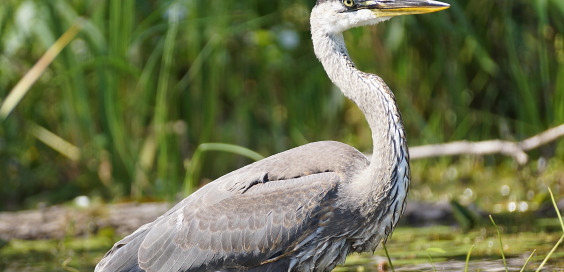
Creature Feature – Great Blue Heron
Posted by Dustin Horton // April 23, 2018 // Creature Feature
A welcome sign of springtime is the return of migrant birds that breed in our region. The great blue heron is one such bird, and what a magnificent bird it is. Standing at 3 – 4-1/2 feet tall atop stilt-like legs, with a long neck and imposing, dagger-like yellow bill, these wading birds strike an impressive silhouette. In flight, the neck is folded into an S, while the legs trail behind. As their name implies, these (adult) herons are dressed in blue-gray plumage, streaked in front with black and white, and sport a black plume atop their head. Look for great blue herons near lakes, rivers, streams and wetland habitats where they stealthily hunt fish, frogs, snakes and other prey. A lightning-quick thrust and stab of their bill nabs the unsuspecting quarry. Webbing between their front two toes prevents them from sinking into the mud. Large colonies of tree-top, stick nests found near water are called rookeries. These sites may have hundreds of nests, some as big as 3-4 feet across. Pairs exhibit dramatic courtship displays as a bonding behavior. Both parents share incubation and feeding duties. It’s important to stay away from active rookeries, as human disturbance is the #1 cause of abandoned, failed nests. Great blue herons are legally protected under the Migratory Bird Treaty Act.
Article and Photo by Margie Manthey













